Supermicro C9Z490-PGW Motherboard Review: Comet Lake with 32 CPU PCIe Lanes
by Gavin Bonshor on December 21, 2020 10:00 AM EST- Posted in
- Motherboards
- Intel
- Supermicro
- PLX
- Z490
- Comet Lake
- LGA1200
- C9Z490-PGW
CPU Performance, Short Form
For our motherboard reviews, we use our short form testing method. These tests usually focus on if a motherboard is using MultiCore Turbo (the feature used to have maximum turbo on at all times, giving a frequency advantage), or if there are slight gains to be had from tweaking the firmware. We put the memory settings at the CPU manufacturers suggested frequency, making it very easy to see which motherboards have MCT enabled by default.
For Z490 we are running using Windows 10 64-bit with the 1909 update.
Update: A Note About Z490 and Turbo
Normally we test our motherboards with out of the box settings. This means that the performance will get boosted based on whatever default algorithm each motherboard vendor implements with regards turbo time and boost power. Intel actively encourages this - the numbers it puts in for turbo time and turbo power are recommendations, rather than specifications, and Intel wants motherboard vendors to engineer their products to the turbo and power that each vendor deems acceptable for their product. As a result, a lot of motherboards will implement an aggressive turbo algorithm.
For this generation, ASUS has done something different. ASUS' enthusiast motherboards offer two different options on first boot: Intel recommendations, or ASUS recommendations. This means that there is a small performance delta between the two, especially for ASUS' high-end motherboards. ASUS has put this into the product based on customer feedback and how motherboard vendors have slowly drifted over the last decade to well beyond what Intel recommends.
For our testing methodology, we try to leave as much as we can on default, because this is part of what makes a motherboard different to any other, and the motherboard vendor has to decide how aggressive it must be. Also, for non-enthusiasts who daren't enter the BIOS, or understand even what turbo or a CPU or what memory channels are, they will just end up with the non-XMP default settings. It is unclear what such a person might select when presented with the ASUS default option.
On the side of Supermicro, as we've noted earlier in the review, whereas most vendors will adjust Intel's recommendations for power limits and turbo, Supermicro appears to adhere to them strictly. This means some performance differential, more akin to ASUS's option for Intel defaults.
Rendering - Blender 2.7b: 3D Creation Suite
A high profile rendering tool, Blender is open-source allowing for massive amounts of configurability, and is used by a number of high-profile animation studios worldwide. The organization recently released a Blender benchmark package, a couple of weeks after we had narrowed our Blender test for our new suite, however their test can take over an hour. For our results, we run one of the sub-tests in that suite through the command line - a standard ‘bmw27’ scene in CPU only mode, and measure the time to complete the render.
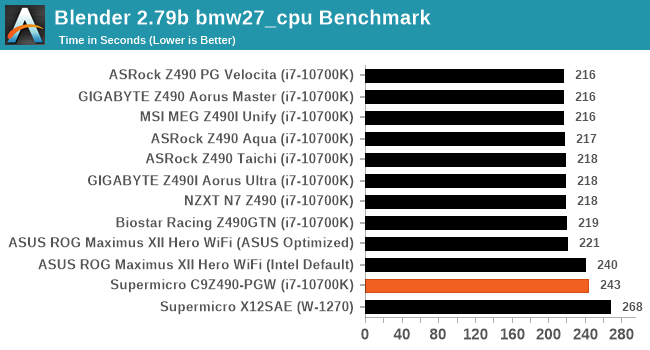
Rendering – POV-Ray 3.7.1: Ray Tracing
The Persistence of Vision Ray Tracer, or POV-Ray, is a freeware package for as the name suggests, ray tracing. It is a pure renderer, rather than modeling software, but the latest beta version contains a handy benchmark for stressing all processing threads on a platform. We have been using this test in motherboard reviews to test memory stability at various CPU speeds to good effect – if it passes the test, the IMC in the CPU is stable for a given CPU speed. As a CPU test, it runs for approximately 1-2 minutes on high-end platforms.

Rendering - Crysis CPU Render
One of the most oft used memes in computer gaming is ‘Can It Run Crysis?’. The original 2007 game, built in the Crytek engine by Crytek, was heralded as a computationally complex title for the hardware at the time and several years after, suggesting that a user needed graphics hardware from the future in order to run it. Fast forward over a decade, and the game runs fairly easily on modern GPUs, but we can also apply the same concept to pure CPU rendering – can the CPU render Crysis? Since 64 core processors entered the market, one can dream. We built a benchmark to see whether the hardware can.
For this test, we’re running Crysis’ own GPU benchmark, but in CPU render mode. This is a 2000 frame test, which we run over a series of resolutions from 800x600 up to 1920x1080. For simplicity, we provide the 1080p test here.
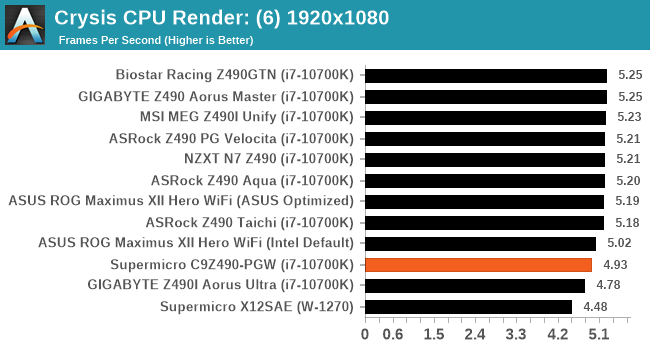
Point Calculations – 3D Movement Algorithm Test: link
3DPM is a self-penned benchmark, taking basic 3D movement algorithms used in Brownian Motion simulations and testing them for speed. High floating point performance, MHz, and IPC win in the single thread version, whereas the multithread version has to handle the threads and loves more cores. For a brief explanation of the platform agnostic coding behind this benchmark, see my forum post here.
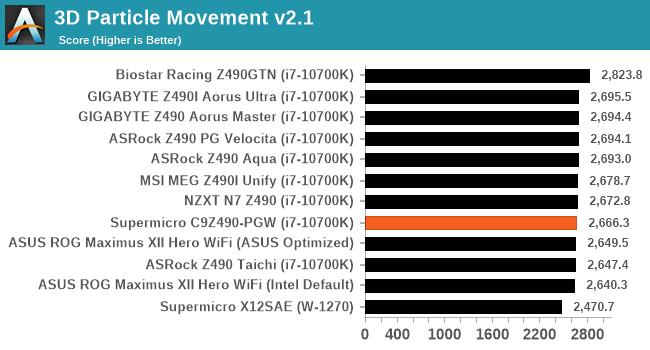
NAMD ApoA1
One frequent request over the years has been for some form of molecular dynamics simulation. Molecular dynamics forms the basis of a lot of computational biology and chemistry when modeling specific molecules, enabling researchers to find low energy configurations or potential active binding sites, especially when looking at larger proteins. We’re using the NAMD software here, or Nanoscale Molecular Dynamics, often cited for its parallel efficiency. Unfortunately the version we’re using is limited to 64 threads on Windows, but we can still use it to analyze our processors. We’re simulating the ApoA1 protein for 10 minutes, and reporting back the ‘nanoseconds per day’ that our processor can simulate. Molecular dynamics is so complex that yes, you can spend a day simply calculating a nanosecond of molecular movement.
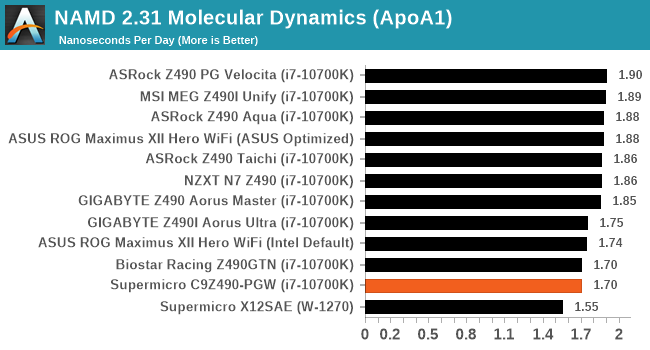


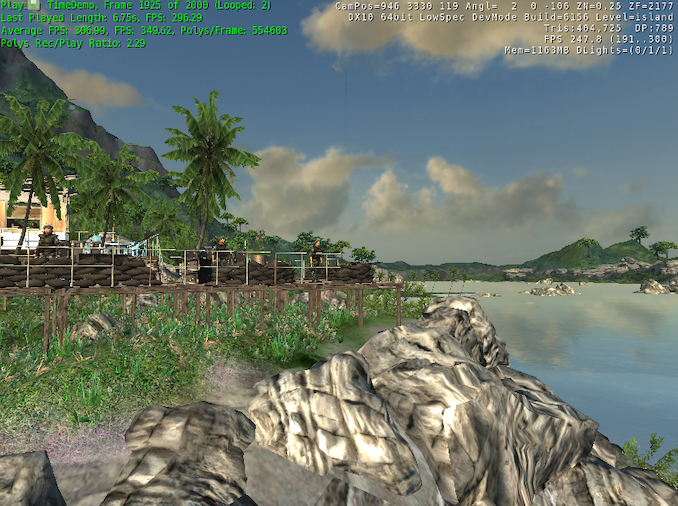








24 Comments
View All Comments
:nudge> - Monday, December 21, 2020 - link
Too little too lakeorsoleads - Monday, December 28, 2020 - link
Great info. This will be great for my new set up. Will be adding to my list to order next week. Thanks a bunch. Regards - http://www.google.comDuncan Macdonald - Monday, December 21, 2020 - link
Or with Threadripper you can have 64 PCIe 4.0 lanes direct from the CPU - no switch required,The total bandwidth on the Supermicro is only that of 16 PCIe 3.0 lanes - the switch does not magically add bandwidth. The bandwidth on Threadripper 3rd gen (3970x etc) is eight times the bandwidth of the Intel CPU (a PCIe 4.0 lane has twice the bandwidth of a PCIe 3.0 lane).
Even the latest Ryzen chips have more bandwidth due to having PCIe 4.0 lanes instead of PCIe 3.0 lanes.
The board is probably on special offer to clear out this deadweight item.
The only good reason for buying it is to replace a broken motherboard.
Jorgp2 - Monday, December 21, 2020 - link
lol the cheapest TR and motherboard combo is like $2000Operandi - Monday, December 21, 2020 - link
Yeah, this particular board is potintless given the platform. Aside from that Supermicro should really lean into what they do best and thats build solid boards aimed at professionals. Sure target the DIY enthusiast but drop the gamer slogans, and marketing, "play harder" ughhh.... just stop.lmcd - Monday, December 21, 2020 - link
The point is specifically the platform. Wouldn't this be one of the only boards capable of 2-card SLI with 3090s (not that such a thing is performant) without a NUMA-required CPU?JimmyZeng - Tuesday, December 22, 2020 - link
Then you'll notice 2 slot 3090s are hard to find.edzieba - Tuesday, December 22, 2020 - link
The x16 slots are 4 slots apart.Jorgp2 - Tuesday, December 22, 2020 - link
Any GPU is single slot if you stick a water block on it.CheapSushi - Wednesday, December 23, 2020 - link
No, shut up. It's great that SuperMicro is making these and it is an option. Why don't YOU focus on other products.